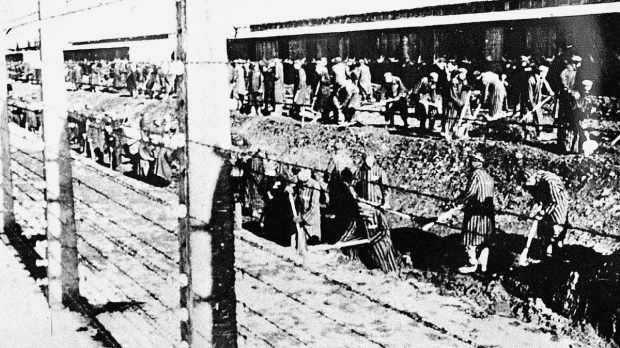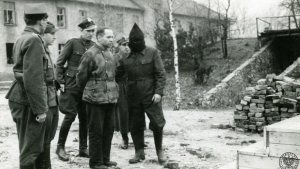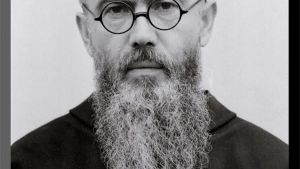Poland is a nation apart. Bullied, oppressed, butchered, tortured, wiped off the map of Europe, condemned to disappear, swallowed by its too-powerful Russian, Prussian, and Austrian neighbors – still it has managed, like a phoenix, always to rise from its ashes. This miracle is the fruit, for the most part, of its Catholic faith. This includes the work and example of indefatigable, patriotic members of the clergy and religious life who, from century to century and in the worst trials, have known how to transmit not only the religion but also the language, history, and literature of a martyred people. This preponderant role of religious and clergy obviously did not escape the notice of those who wanted to destroy the Polish soul, and it made them the target of persecution.
Companion of Maximilian Kolbe
Before the communists, the Nazis – who were also open enemies of Catholicism – targeted the Polish Church as soon as the country was occupied. In a few months, 1,117 nuns and 3,646 priests and religious were arrested and sent to concentration camps. One hundred twenty of them were selected for Dachau to be used in the “medical experiments” that took place there. Only 999 were still alive at the end of the war. If the figure of St. Maximilian Kolbe, which has become emblematic and universal, seems to sum up all these fates, it would be unfair not to dwell also on his fellow prisoners. Among them was Fr. Piotr Edward Dankowski, who died in Auschwitz on April 3, 1942, at the age of 33. He was beatified in 1999.
Piotr was born in Jordanow, in the Carpathian Mountains, on June 21, 1908. Early in life he became aware of his vocation and entered the seminary in Krakow. He then attended the prestigious Jagiellonian University where he studied theology. He was ordained a priest on February 1, 1931, a little before the canonical age of 24. He began his ministry as a chaplain in Krakow and was later appointed curate in several parishes of the archdiocese, before finally becoming a parish priest in Zakopane, in his native region.
He quickly established himself as a local figure. He ran in regional elections (which was not surprising at the time), but he also was known for his intellect. Fr. Dankowski gained a small literary reputation by publishing a few works of spirituality and meditation. He was an attentive and gifted catechist and was much loved by young people. He was also an excellent spiritual director, a role he carried out at the Albertine Sisters’ convent.
Clandestine radio
This studious and pious life was disrupted in September 1939 by the invasion of Poland and the defeat of its troops. Like so many Poles, Fr. Dankowski was not resigned to this defeat. Although the young priest continued his pastoral duties, he soon joined the Resistance along with his brother Stanislas. Under the pseudonym of Jordan, an allusion to his hometown, Fr. Piotr agreed to take on one of the most perilous missions: radio. A clandestine radio station was set up at the rectory, making it possible to communicate across the border and across the Carpathian mountain range with other resistance networks in Hungary, Romania, and Slovakia.
In all the occupied countries, putting these radio communications out of service was one of the priorities of the Germans. They installed instruments to triangulate the radio signals in cars which they sent criss-crossing the streets and countryside, working hard to locate the transmission sites. The clandestine stations regularly changed location, but not always quickly enough, and bad luck could interfere. Fr. Dankowski was caught after a few months. He was arrested, beaten, and tortured in order to make him betray his network. He kept silent.
The gas chamber
Imprisoned in Tarnovo, he continued to keep silent despite being subjected to the worst treatments. He was then transferred to Auschwitz and assigned to a forced labor team within the IG Farben factory. They were subjected to unbearable working hours, deprivation of food and basic care, beatings, bullying, and intense cold. The deportees experienced the whole cruel arsenal of a system made to destroy people morally and spiritually as well as physically. Many collapsed, let themselves die, or – in order to survive at all costs – turned into beasts ready to do anything for a little extra food, even if it meant crushing those who were weaker. It took exceptional fortitude and an unshakeable faith not to be carried away by the power of unbridled evil and to continue to hope against all hope.
Those of his comrades who returned from Auschwitz would say that Fr. Dankowski was a beacon of hope to the end. Was he finally killed precisely because he was a light in the midst of this hell, a beacon and a support for the other prisoners? Was it because he was no longer able to keep up with the pace of the forced labor team, which was designed to exhaust the prisoners? Was it an act of revenge of a guard? We’ll never know, since the entire policy of the camps was based on the principle of Nacht und Nebel, night and fog, which consisted of making the prisoners disappear without it being possible to know exactly what had become of them or how they had died. On April 3, 1942, Fr. Piotr Edward Dankowski was taken to the gas chamber. His last words to his comrades were, “To God! To Heaven.” It was Good Friday.



